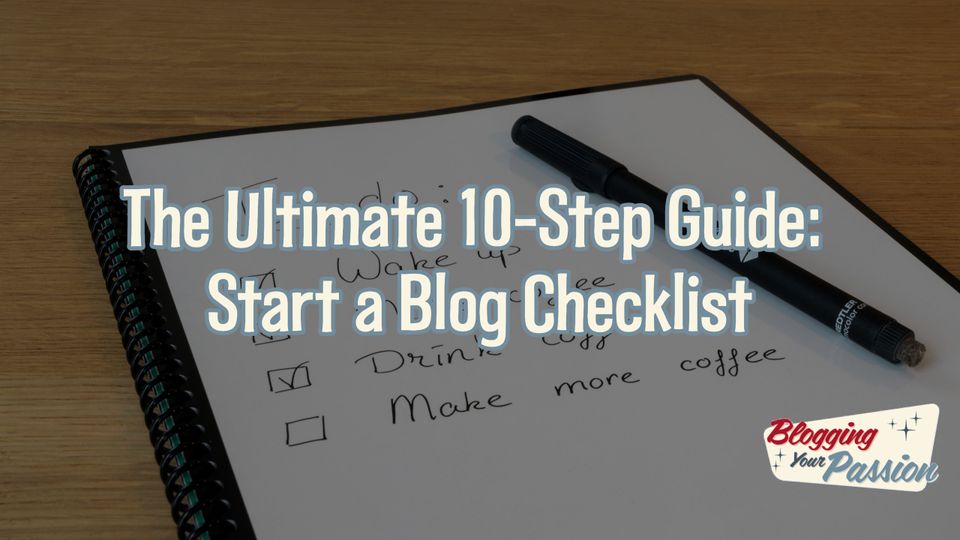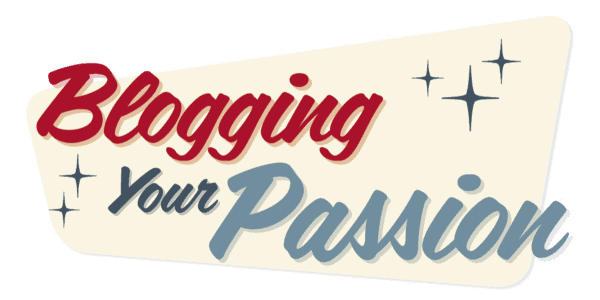The Ultimate 10-Step Guide: Start a Blog Checklist

So, you want to learn how to start a blog?
Awesome!
Before you buy that domain name or that hosting package, you have some important questions you need to answer first.
Starting a blog can be both exciting and daunting.
With many tasks and decisions to complete, it can be easy to become overwhelmed and feel like giving up.
However, overcoming any obstacle and achieving success is possible with hard work, perseverance, and determination.
That's where a checklist comes in - keeping organized, focused, and not missing any vital steps is paramount to successful blog ownership.
A blogging checklist is a detailed guide and roadmap to your successful blogging experience.
Table of Contents (click to expand)
- How to Start a Blog Checklist
- Step 1. Establish Your Blogging Goals
- Step 2. Choose Your Blogging Platform
- Step 3. Select a Theme and Design For Your Blog
- Step 4. Set Up Your Blogging Foundation
- Step 5. Create a Content Strategy for Your Niche
- Step 6. Launching a Blog Checklist: Your Brand and Voice
- Step 7. SEO Optimize Your Blog for Search Engines
- Step 8. Integrate Social Media and Email Marketing
- Step 9. Blog Startup Checklist for Monetizing Your Blog
- Income Source 1. Making Money with Affiliate Marketing
- Income Source 2. Making Money with Ads on Your Blog
- Step 10. Start Your Blog Checklist - Analyzing Its Performance
- FAQs about Starting a Blog Checklist
- What are the steps to starting a blog?
- What Do I Need for My Starting a Blog Checklist?
- What factors should I keep in mind when choosing a blog theme?
- Do I Need Experience to Start My Blog?
- How should I prepare for my blog launch?
- What Are the Four Main Components of a Blog?
- What are the steps to starting a blog?
- Conclusion: The Ultimate Start a Blog Checklist
How to Start a Blog Checklist

Our start a blog checklist outlines all the essential tasks and decisions necessary for starting a blog successfully while helping keep things organized.
By following a checklist step-by-step, you can tackle each stage one at a time while staying organized while not overlooking key components that could compromise its success.
Step 1. Establish Your Blogging Goals
To help set yourself up for blogging success as a beginner, it's essential that you first set out a set of blogging goals and objectives.
Doing this will keep your focus on track with your overall vision while keeping readers coming back for more.
Among many steps in establishing goals is identifying your ideal reader/audience. This helps ensure content that resonates with them - thus keeping readers coming back for more!
Understanding your target audience can also help create content that keeps readers coming back - something novice bloggers often struggle with when starting their profitable blog journeys as beginners!
Other goals should include optimizing content for Google search results, such as using the WordPress editor, which will speed up reaching goals even quicker! More on this later.
Step 2. Choose Your Blogging Platform

When it comes to blogging platforms, there are various available solutions with their own advantages and disadvantages.
My personal favorite is Ghost. It's a simpler version of WordPress and something I strongly recommend to my clients who feel tech challenged.
Other popular ones are WordPress blog, Blogger, and Squarespace. Consider factors such as ease of use, customization options, and scalability before making a final choice.
After selecting a blogging platform, the next step should be selecting a domain name. Your domain name serves as the online address of your blog; therefore, it's crucial that it reflects both your brand identity and is easy to remember.
Avoid numbers or hyphens, as these may make the domain difficult to type. Opt for short, memorable domains with free domain name registration!
Step 3. Select a Theme and Design For Your Blog
What's the best way to design your blog?
When it comes to blogging, what theme should you choose?
Your blog theme and design play an essential role in drawing readers in.
When selecting a premium theme, keep the following factors in mind when making your choice:
- responsiveness
- customization options
- compatibility with plugins
- visual appeal
- functionality
- and user experience.
Additionally, great content is crucial for keeping readers engaged and returning for more.
Once you have chosen a theme, it's time to customize the blog's design in accordance with your branding and choose a good domain name.
This involves choosing colors, fonts, and graphics that reflect your brand identity.
Consistency should be key here - ensure that the blog reflects the same look and feel as other branding materials such as your logo and social media profiles.
Keep things as minimal yet effective as possible when selecting design elements.
Step 4. Set Up Your Blogging Foundation
Establishing the foundation for your blogging requires several tasks, including:
- setting up hosting
- installing necessary plugins
- and creating key pages like About and Contact.
Hosting services like Bluehost allow your blog to become accessible online, and it's important to make sure your home page is well-designed and easy to navigate.
Do your research and choose a hosting service that meets all of your requirements in terms of speed, reliability, and customer support.
Plugins are small pieces of software that add extra functionality, enabling you to try out new things and experiment with new ideas.
Some essential plugins for SEO, social sharing, and contact forms could improve your site's performance and user experience.
Establishing essential pages like About and Contact is vital for building trust with your readers.
An About page gives readers the chance to get acquainted with you, while Contact page allows readers to reach out.
Ensure these pages are easily found from your homepage with all pertinent details included on each.
Step 5. Create a Content Strategy for Your Niche
A content strategy provides an organized way to produce and disseminate quality content in line with your blogging goals and objectives.
It involves selecting topics for discussion, conducting keyword research, and publishing an editorial calendar while keeping yourself on track to meet those goals!
It allows for greater audience relevance while helping achieve blogging success, especially when applied to a WordPress website.
An editorial calendar is an easy and effective way to plan and organize content for your homepage.
By setting aside specific dates and topics for publication, an editorial calendar helps ensure a steady stream of fresh posts on your blog and allows you to stay on track without scrambling last minute for ideas or older posts.
Step 6. Launching a Blog Checklist: Your Brand and Voice
Branding refers to developing an individual identity for your blog, including a tagline.
This involves defining its personality, values, and tone of voice - making sure they remain consistent from design through content production.
This helps build trust with readers while making your website memorable.
It's important to avoid adding unnecessary fluff to your branding, as it can dilute your message and confuse your audience.
As you create your brand's voice, consider factors like the target audience, the blog's purpose, and personal style.
Do you wish for your blog to be informative, conversational, or humorous?
Whatever tone you decide should reflect its personality while engaging the target audience.
Step 7. SEO Optimize Your Blog for Search Engines

Search engine optimization (SEO) is improving the visibility of your website in search engine results pages, increasing organic traffic to it while increasing chances of discovery by potential readers.
SEO should play an integral part in driving organic growth for any blog and increasing the chances of discovery by new readers.
To optimize your website for search engines, conduct keyword research to understand which terms and phrases your target audience are searching for.
Incorporate these naturally into your posts' titles, headings, and body to increase readership and keep Google happy.
Also, ensure your structure is search-engine-friendly by creating descriptive URLs, adding meta tags, and optimizing images - these steps should ensure maximum search engine results!
For more tips, check out my ultimate guide to blog post SEO for bloggers.
Step 8. Integrate Social Media and Email Marketing

Social media and email marketing are powerful tools for promoting your blog and engaging with its target audience.
Social media provides a way to:
- Share articles.
- Interact with readers.
- Build a following.
- And build community around your blog.
While email marketing provides an effective means of staying in touch with readers, nurturing leads, and driving traffic back to it.
To integrate social media into your blogging strategy, identify which platforms are most popular among your target audience.
Create profiles on these platforms and post updates regularly, engaging with followers by responding to comments and messages and sharing relevant content from outside sources that add value.
Email marketing involves building an email list of subscribers interested in your blog and offering them something of value, such as an ebook or free course in exchange for their email address.
Next, send regular newsletters or updates that feature recent articles while offering additional value through exclusive content or promotions.
Step 9. Blog Startup Checklist for Monetizing Your Blog
Now that your content has become strong and established let's examine various monetization opportunities for bloggers.
Advertising and affiliate marketing are two popular income methods for bloggers.
Advertising is an easy and reliable way to monetize your website, with ads showing on pages or clicks earning you money based on impressions or clicks.
Google AdSense provides an efficient advertising network that simplifies this monetization process with its user-friendly interface so you can seamlessly integrate ads into your blog and start earning immediately.
Affiliate marketing provides another exciting avenue for monetizing your website by promoting products or services on your platform and earning commission from each sale or lead generated through referral.
Joining reliable affiliate networks like Amazon Associates or ShareASale will allow you to discover products relevant to both your content and audience.
As you embark on your monetization journey, it is key that you strike a balance between earning income and providing an optimal user experience.
Oversaturating readers with ads or promotional material could irritate their engagement with your blog, ultimately driving readers away and disrupting engagement - building trust with readers should always remain your number one goal!
Let's dive into my checklist for both income models.
Income Source 1. Making Money with Affiliate Marketing
Follow this checklist to earn money blogging with affiliate marketing:
1. Define Your Niche and Target Audience: Careful analysis of your audience can help select suitable affiliate products and services to promote.
2. Evaluate Reputable Affiliate Programs: Take time to investigate various affiliate networks and programs until you find those that align with the content and values of your website, offer competitive commission rates, and deliver quality products or services.
3. Select products or services you believe in: Your readers trust you, so when making recommendations through an affiliate link, only recommend products or services you personally tried and endorse yourself. Doing this will create authenticity with them and increase their chances of purchasing through it.
4. Produce engaging and useful articles: Focusing on crafting engaging articles that resonate with your target audience will bring more readers and increase the chance they click through your affiliate links.
5. Integrate affiliate links naturally: Use affiliate links within blog posts in a natural manner to not overwhelm readers with too many links at once.
6. Evaluate Your Results: Leverage tracking tools provided by an affiliate network to evaluate the performance of your affiliate links, helping determine which products or services generate more clicks and conversions to maximize your efforts.
9. Diversify Your Affiliate Partnerships: While selecting reliable affiliate programs is essential, avoid relying too much on one partnership. Explore opportunities that align with your niche and target audience - this will open more earning potential while mitigating over-dependence risks.
10. Experiment and Optimize: Don't be intimidated to try new strategies in your affiliate marketing journey. Experiment with various promotional methods (video content production or webinar hosting can prove highly successful) to see which resonates with your target audience.
11. Be Open and Honest: Trust is key in any successful affiliate marketing venture, so always disclose any affiliations or affiliate links within articles, such as sponsored content or affiliate links.
12. Stay Organized and Consistent: Blogging success requires creative content creation and organization skills. Use a content calendar or planner to manage and plan out posts in advance.
Income Source 2. Making Money with Ads on Your Blog
Follow this checklist to ensure a successful monetization strategy:
1. Plan Ad Placements Strategically: Think carefully about where ads would fit within your website layout without overshadowing content and user experience. Find an optimal balance between visibility and user experience when placing ads on your blog.
2. Optimize Ad Sizes and Formats: Experiment with different ad sizes and formats to find out which work best on your blog. You want ads that blend in seamlessly with the design without distracting readers or being annoying to the reader experience.
3. Balance Ads: Avoid overcrowding your website with too many ads as this can create an unpleasant user experience and generate revenue simultaneously. Strive to balance earning revenue while offering your audience a pleasant reading environment.
4. Select Reputable Ad Networks: You must select reliable ad networks to ensure timely payments and access to high-quality ads. When researching various options and reading reviews, take time to consider factors like payout rates, relevance and customer service before settling on one.
5. Monitor Ad Performance: On an ongoing basis, assess your advertisements' performance by keeping tabs on metrics such as click-through rates (CTRs) and conversion rates. This data will allow you to identify the most effective placements and tailor your monetization strategy accordingly.
6. Experiment With Different Ad Placements: Don't be intimidated to experiment with various ad placements until you find one that works well with your website. A/B testing provides data-driven decisions.
7. Prioritize User Experience: While ads may be necessary to monetizing your blog, it is critical that they enhance user experience above all else. Ensure the ads you select are non-intrusive and relevant allowing readers to easily navigate and consume your content without being interrupted by disruptive banner ads.
9. Optimize for mobile devices: With more people accessing the internet through mobile phones than ever, it's crucial that your blog is optimized for viewing on smaller screens. Make sure all ads are responsive, loading quickly without negatively affecting speed or layout on smaller displays.
10. Keep Your Design Up-to-Date: Keep your web design current to ensure an engaging experience for readers, reflecting current trends and making navigation simple and user-friendly. Considering adding visual elements such as images or videos to enhance its overall aesthetic.
Step 10. Start Your Blog Checklist - Analyzing Its Performance
Analyzing your blog's performance is essential to understanding its success and where improvements need to be made.
Analytics provide invaluable insight into its traffic, engagement, and conversion rates - data which enables data-driven decisions aimed at optimizing it and increasing its success.
Google Analytics is a powerful tool that lets you keep an eye on various metrics, including:
- visitors
- page views
- bounce rate
- conversion rate
- and demographic information.
Use this data to track trends, better understand your target market and make smarter decisions regarding your blog's content production and marketing strategies.
Understanding the performance of your blog is crucial for its growth and success.
By employing analytics tools, you can gather invaluable insight that will allow you to make data-driven decisions to enhance it further.
Once your website is up and running, it's important to regularly maintain and update it with fresh content, update plugins and themes, monitor its performance, and manage any potential security risks.
Doing so keeps your audience engaged while increasing search engine results' visibility.
Focus on providing value to your audience when developing fresh content.
Write engaging, informative articles that cater to their needs and interests while updating old posts with fresh information or insights to keep them relevant and improve search engine rankings.
FAQs about Starting a Blog Checklist
What are the steps to starting a blog?
The steps to starting a blog include:
- Choosing a niche.
- Selecting a blogging platform.
- Registering a domain name.
- Setting up web hosting.
- Designing your blog.
- Creating compelling content.
- Promoting your blog.
- Engaging with your audience.
- Monetizing your blog.
- And analyzing your performance.
What Do I Need for My Starting a Blog Checklist?
In order to start blogging, you will require several key items:
1. Select Your Niche or Topic: Once your niche or topic of choice has been decided upon - for instance, fashion and beauty or travel are among your choices - decide which aspect or niche or topic of that niche/topic will be your focus.
2. Domain Name: Make your blog's domain name memorable while reflecting your niche. Be sure that the spelling and pronunciation are easily understandable for readers.
3. Web Hosting: When selecting a reliable hosting provider for your website, look for features such as server uptime, security measures, and customer support that make life easy for both the customers and you.
4. Content Management System (CMS): Select an intuitive CMS platform like WordPress for ease of use and an array of customization features.
What factors should I keep in mind when choosing a blog theme?
There are a few aspects of picking your blog's theme you need to keep in mind:
1. Responsiveness: Make sure the theme is mobile-friendly and adapts to various screen sizes; this is important as more and more people access websites via mobile devices.
2. Design and Layout: Select a theme that aligns with your brand and conveys the style and tone you wish to portray. Take into account overall aesthetic, colors, fonts, and visual elements which will amplify content creation.
3. Customizability Options: Choose a theme with customizable features to make your blog truly unique and personalized.
Do I Need Experience to Start My Blog?
Starting a blog without prior experience may seem intimidating, but it is entirely doable. Below are some steps that will assist in the process:
1. Research and Learn: Take some time to educate yourself about blogging by researching articles, watching tutorials, joining online communities and gaining advice from experienced bloggers.
2. Set Goals: Define why and what your desired outcomes for starting a blog are; having set clear goals will keep you focused and motivated during this journey.
3. Select Your Niche: Find something that piques your interest, has potential growth potential and that has your focus.
How should I prepare for my blog launch?
Successful blog launch preparation requires several key steps. Here is a checklist to ensure a smooth launch:
1. Content Production: Create a backlog of high-quality and engaging posts before launching your blog, at least five or ten of which should be well-written and informative posts.
2. Brand and Design: Make sure your blog's design fits within the framework of your brand identity by customizing the theme, selecting colors and fonts appropriate to the blog topic and developing a captivating logo.
3. SEO Optimization: Research keywords related to your niche and incorporate them naturally into the content you write. Utilize an SEO plugin or tool for each post you publish to further optimize it for search engines.
4. Establish Analytics: Install an analytics tool such as Google Analytics to monitor the performance of your blog and gain valuable insight about its readership.
5. Social Media Integration: Establish accounts on popular social media platforms that correspond with your target audience and connect these accounts to your blog; use these platforms to promote content produced on your blog by setting up presence on these sites.
6. Test and Debug: Make sure the functionality of your blog is tested by browsing various pages, testing forms and verifying all links are working as expected.
7. Create an Email List: Utilize an email marketing platform and opt-in forms to collect email addresses from your readers, building an engaged following that stays updated on new posts or exciting offers.
8. Networking: For maximum exposure and to reach more readers, reach out to fellow bloggers in your niche and form relationships. Guest blogging or collaborating with them may increase visibility while expanding reach.
9. Promotion Strategy: Create a comprehensive promotion strategy for launching your blog, taking advantage of social media, email newsletters, online communities, and any other relevant channels to drive visitors and interest in your content.
What Are the Four Main Components of a Blog?
In order to write an effective blog, there are four components you should focus on when developing one: content creation, design, promotion and engagement.
1. Content: Keyword research for your niche and incorporation naturally into blog content will ensure higher search engine results and more visitors.
2. Design: For optimal user experiences, an appealing and user-friendly design is crucial to creating an unforgettable online experience. Ensure that your blog boasts an attractive layout with easy navigation features and mobile responsiveness to cater to readers across devices.
3. Promotion: Now that you have created high-value content, it is important to share it. Utilize social media, email newsletters and any other relevant channels to reach a wider audience with your posts and encourage them to spread the word themselves. Engage with your target demographic while encouraging them to spread it themselves!
4. Engagement: Engaging with your readers on social media and encouraging discussions within your blog community are essential for its success. Responding to comments, engaging with readers through social media interactions, and inviting dialogue will increase engagement and allow you to better understand your target audience and tailor content accordingly.
Maintaining a successful blog requires continuous work and commitment from you and your audience.
Make sure your target market feels engaged by consistently creating high-quality posts regularly that engage them so they come back for more!
Keep your readers coming back for more!
What are the steps to starting a blog?
The steps to starting a blog include choosing a niche, selecting a platform, finding a domain name, setting up hosting, designing your blog, creating content, promoting your blog, engaging with readers, monetizing your blog, and analyzing and improving your performance.
Conclusion: The Ultimate Start a Blog Checklist
Beginning a blog can be both challenging and rewarding.
Adhering to an exhaustive checklist ensures you don't overlook any essential steps and increase the chance of establishing an effective blog.
Everything from setting goals and objectives to to maintaining, updating, and hosting is integral to its overall success.
Use this checklist as a road map for your blogging adventure.
Tailor it to fit your individual needs and goals, and don't be afraid to make adjustments along the way.
Building a successful blog requires time, dedication, and consistency.
Consistently provide value to your readers while enjoying creating and sharing your content with the world!
